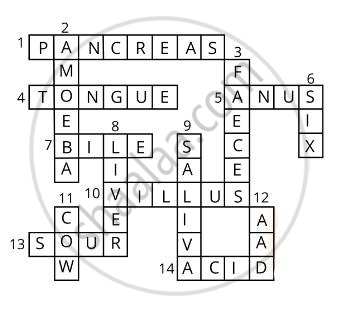Advertisements
Advertisements
Question
Solve the crossword given in Figure 2.3.

| Across | Down | ||
| 1 | Cream-coloured digestive gland | 2 | Feeds with the help of pseudopodia |
| 3 | Undigested excretory solid residues | 6 | Total number of molars in one jaw of an adult |
| 4 | Organ that mixes saliva with the food | 8 | Largest gland |
| 5 | Point of defecation | 9 | Watery secretion in the mouth |
| 7 | Stored in gall bladder | 11 | A ruminant |
| 10 | Finger-like outgrowth in the small intestine | 12 | Form of food chewed by ruminants |
| 13 | Kind of taste buds | ||
| 14 | Kills bacteria in the stomach | ||
Solution

APPEARS IN
RELATED QUESTIONS
Which of the following are the correct functions of two components of pancreatic juice trypsin and lipase?
(a) trypsin digests proteins and lipase carbohydrates
(b) trypsin digests emulsified fats and lipase proteins
(c) trypsin digests starch and lipase fats
(d) trypsin digests proteins and lipase emulsified fats
When a person puts food in his mouth, then teeth cut it into small pieces, chew and grind it. The glands A in the mouth secrete a substance B which is mixed with the food by tongue. The substance B contains an enzyme C which starts the digestion of food in the mouth. The slightly digested food from the mouth goes down a tube D. The special type of movements E in the walls of tube D push the food into stomach for further digestion. The stomach wall secretes gastric juice containing three substance F, G and H. One of the functions of F is to kill bacteria which may enter the stomach with food. The substance G protects the inside layer of stomach from the damaging effect of substance F whereas substance H is and enzyme for digestion. The partially digested food then enters into small intestine for further digestion.
(a) What is (i) gland A (ii) substance B, and (iii) enzyme C?
(b) Name the tube D.
(c) What is the movement E known as?
(d) What are (i) F (ii) G, and (iii) H?
List in tabular form two differences between pepsin and trypsin.
Gastric juice contains
Give Scientific reasons:
Consuming iodized salt in day to day diet is essential.
Put a tick (✓) against the most appropriate alternative in the following statement.
The teeth which help in tearing the food are the:
Observe the diagram given alongside and answer the following:
- Name the parts numbered 1-8.
- Which parts shown in the diagram are non-living?
- Is the tooth suited for cutting, tearing or grinding?
- What is the function of parts 8 and 7?
- What is the total number of teeth present in adult human beings?
- Write the dental formula of human beings.

Name the organs of the digestive system
Describe the alimentary canal of man
How does tooth enamel get corroded? What is the preventive measure for this?
